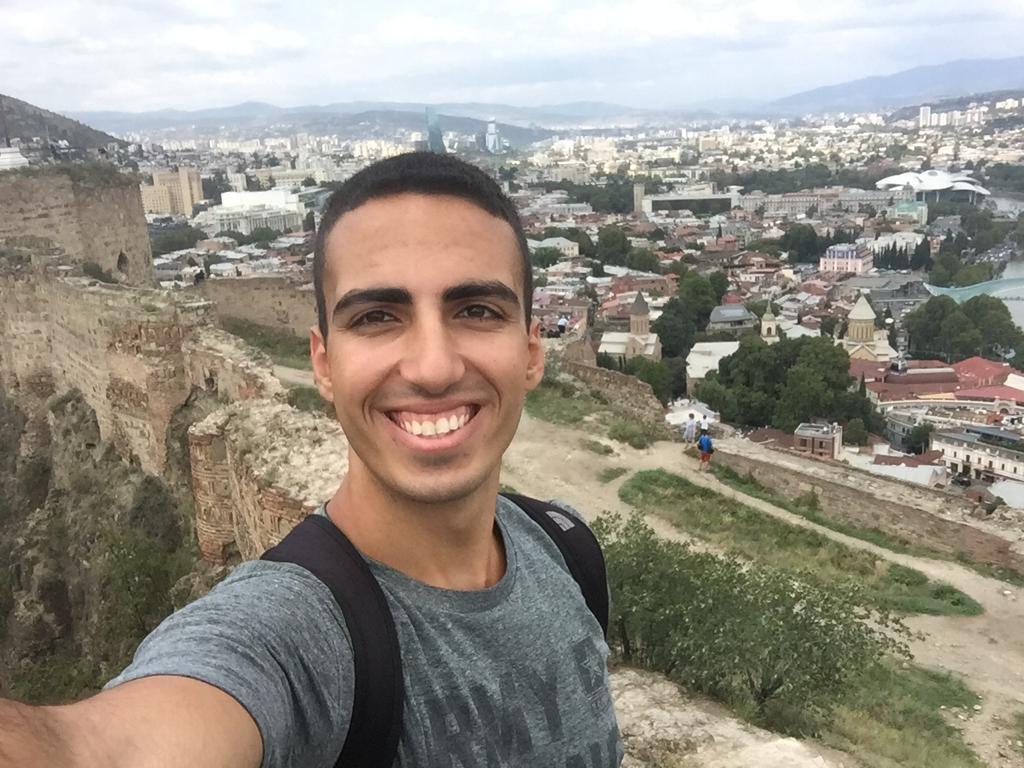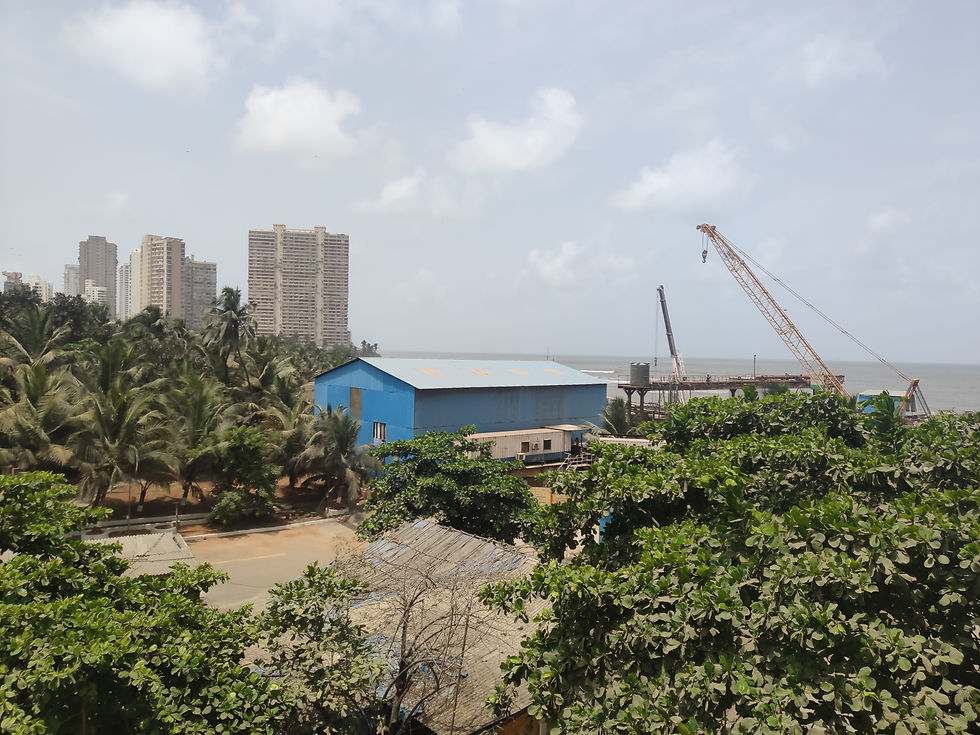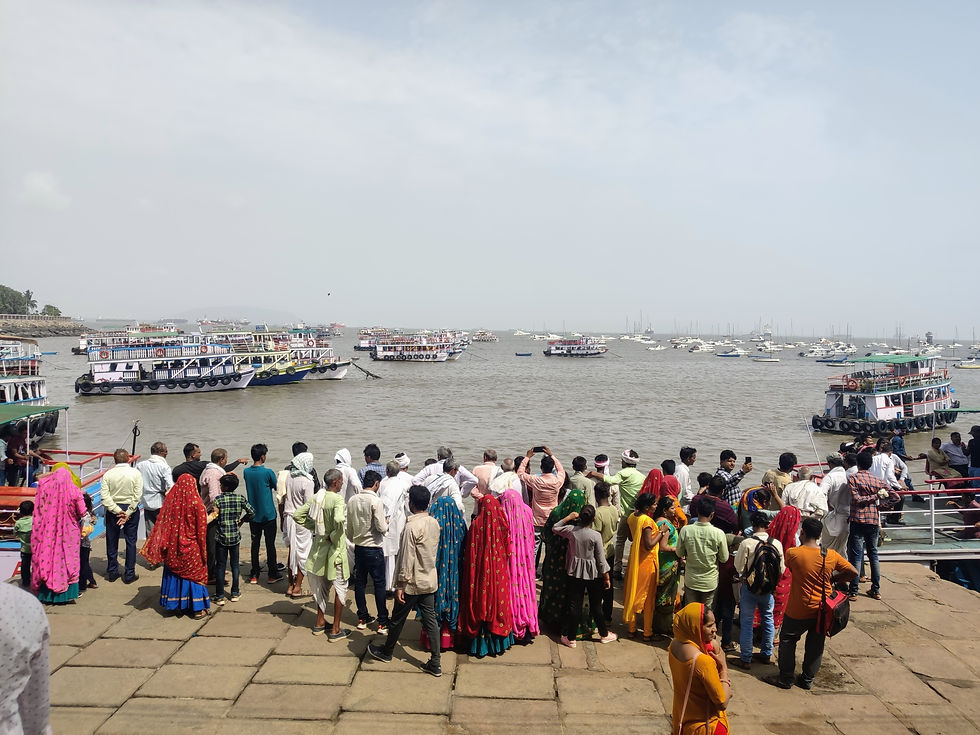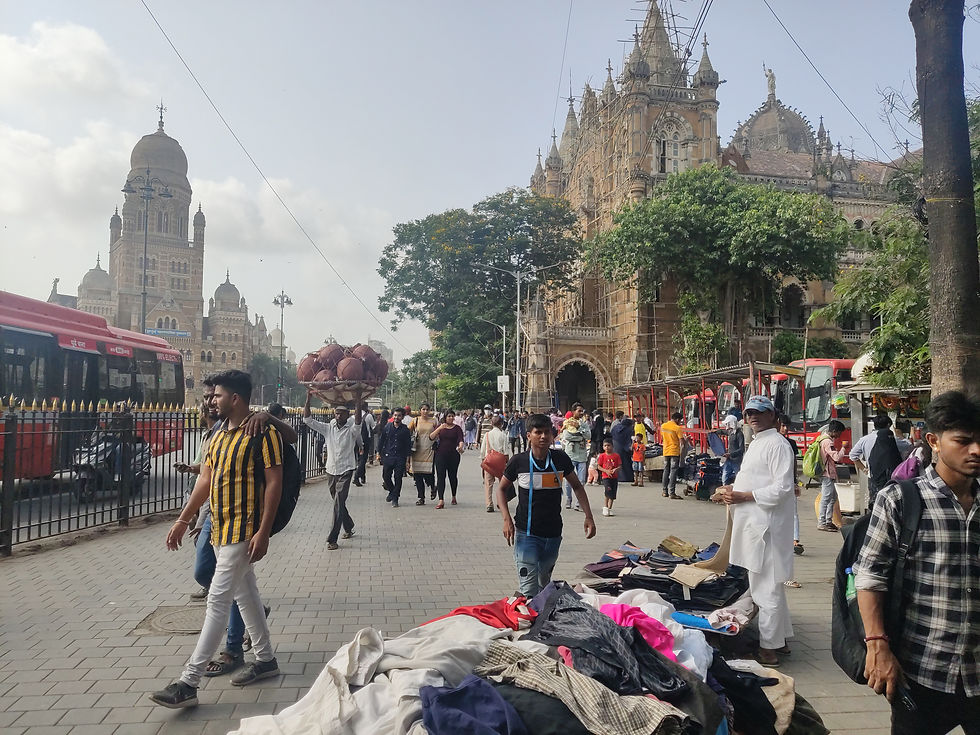Mumbai I: City of Extremes
- Aaron Schorr

- May 15, 2022
- 8 min read
With finals over, I boarded a flight to Zurich and onward to Mumbai. The A330 spent over an hour in Iranian airspace, time which I spent glued to the window in the hope of getting a look at that forbidden country. The skies were unfortunately grey from horizon to horizon, but I got a brief break just long enough to get a glimpse at Tehran, and – most excitingly for me – the Ayatollah Khomeini International Airport.
Chocolate and Champagne
The flight was otherwise uneventful until I realized I had lost my Indian immigration form and headed to the rear galley to get a new one. There, I encountered two of the flight attendants and a Swiss man in his 30s who was very clearly drunk. The man immediately started quizzing me, and rapidly made it clear that he was very gay and very much hitting on me, though he did say I “wasn’t beautiful like an Israeli.” When I told him I wasn’t interested, he asked me if I was a member of the mile-high club and asked me if I wanted to join it with the female Indian flight attendant, who was standing 3 feet behind him. At this point, the male Swiss attendant broke out a bottle of champagne and another of Campari, and poured us all drinks. The man’s name was Casi, and he claimed to be both a university administrator and a cardiologist, inviting both me and the stewardess to lie on the ground and receive an examination after we expressed our doubts.

I was appalled, but at least I had made friends with the flight attendants. The Swiss one in particular seemed thrilled that someone else on the flight spoke German and wasn’t trying to pick him up, and discreetly poured me another glass of champagne from a hidden bottle at the bottom of the drink cart when he came down the aisle. “Das darf nur niemand sehen,” he warned, and later came back with a paper bag full of chocolates that he left on the seat beside me. “Was kleines zum Mitnehmen, sonst werden sie alle weggeschmissen” (a little something to take with you, otherwise they’ll all be thrown out).
We landed in Mumbai and made the seemingly endless trek to immigration. The purpose of the India trip was ostensibly to visit my friend Pradz, and through some coincidence his mother Prati had ended up on the same flight as me. I used my duty-free allowance to get two bottles of steeply-discounted alcohol, and we hopped in a car across the beautiful Sea Link bridge to her South Mumbai home. I was joined in the early hours of the morning by Richard, whom readers of this blog may remember from the January 2021 cross-country road trip.

Pradz’s family used to live on the beach, until the government reclaimed a roughly 100-meter-wide strip of land beneath their apartment building to build a new road to alleviate traffic. It isn’t just the construction that ruins the view of the Arabian Sea, though – most of that credit belongs to the thick smog that hangs over the city. The thing that hits you even before the smog is the heat. The air is thick and humid, and feels like 45º C during the day or a cool 38º at night.
Pradz was only arriving later, so Prati and her husband Sanjay planned us a sightseeing route and sent it to their driver to take us around. We drove into the city and stopped at the Gateway of India, an arch built to commemorate the visit of King George V and and Queen Mary in 1911. In a great twist of irony, the last British troops to leave India passed through the Gateway in an elaborate ceremony in 1948. This was my first visit to India, but it was exactly what I had expected – bustling young crowds, street vendors selling chai and ice cream, and the constant din of horns in the background. We asked someone to take a picture of us, but he immediately asked to take a picture with us, gradually adding members of his family to the photo. This repeated itself many times as we circled the monument, posing with families, teenagers, and a young man killing time before a job interview at the nearby Taj Hotel.


Richard bought a month’s supply of antimalarial medicine for 22 rupees (28¢) and we continued to the Chhatrapati Shivaji Maharaj Vastu Sangrahalaya (formerly the Prince of Wales Museum), a spectacular structure housing a diverse collection of Indian art and cultural artifacts. Our Yale IDs were shockingly enough to get us student admission, which was 50 rupees instead of 650 for foreigners. Tellingly, the jewelry collection contained a number of diamond replicas, with the originals scattered between the Tower of London, the Louvre, the Kremlin, and the Smithsonian. It’s not just the museum that bears the name of Chhatrapati Shivaji Maharaj (or simply “Shivaji”), but the airport and the main train station, too. Shivaji was a 17th-century statesman who gained independence for Maharashtra – the Western Indian region containing Mumbai – from the Mughal Empire. He has been embraced by Indian nationalists as a Hindu hero, but according to Bilal (more on him later) is only the “eighth-most important Marathi figure.”

Speaking of the train station, that was our next stop. We got dropped off at a strange traffic island that doubled as an observation platform in the middle of a busy intersection and made our terrifying way across, only to have to walk in the street since there were fences separating it from the sidewalk. The station itself is a magnificent Gothic structure with Indian flair, and has all the bustle I’d expected, with families preparing for long journeys on trains that look like relics from another era.


Our final stop for the day was the end of Marine Drive, the coastal road that runs along the bayshore. It was full of families, and was vaguely reminiscent of a smoggy Miami, with plenty of Art Deco buildings lining the road. The smog is such a problem in the city that all the buildings, even new luxury apartment towers, look vaguely grimy and discolored from the constant exposure to the dirty, sticky climate. Despite that and my expectations, the streets in central Mumbai are remarkably clean, certainly less full of trash than any city in the US. The other striking thing was the demographics, which are radically different from anywhere in the West. The median age appears to be 20, with rarely anyone over the age of 60, and men seem to be more represented by a factor of 3 than women.

We returned home to have dinner with Leana and Milan – two friends of Prati and Sanjay who were eager to meet the visitors from the US. Dinner was a multi-hour affair, and I joked that it was five courses – one course of biryani and four of drinks. Both the hosts and the visitors kept the whiskey and gin flowing, and when we ran out of ice, Leana sent her driver over with a fresh bucket. Milan was a Bollywood director, and had just finished a 45-day shoot for an upcoming series during the recent heatwave, when temperatures exceeded 45º daily. Leana had also clearly developed a taste for the theatrical, and had insisted that she arrive at her wedding in a 1942 Buick which needed to be outfitted with air conditioning for the occasion.
"The grime-ridden metropolis-of-dreams”
I had definitely had too much whiskey the previous night, and took the morning to let my stomach recover. After lunch, we headed out to a railway station to meet a guide who would be taking us on a tour of Dharavi, one of the city’s largest slums. The tours were run by locals, 80% of the profits were invested in local education, and photography was not allowed for obvious reasons (I managed to snap some photos at the edge of the district or when nobody was around). I had insisted that we take the train there for the experience, and it did not disappoint. The trains travels with all its doors wide open, and passengers hang out the sides while holding on to poles and handles. Trains depart every few minutes along the 124-km line (one of three), giving Mumbai better commuter rail service than any city in the US. Our return ticket cost 20 rupees (26¢). Along the route, our guide pointed out dabbawalas, a network of 5,000 men who deliver over 200,000 lunches to workers every day across the “grime-ridden metropolis-of-dreams”, as the dedicated website explains.

We arrived at our station and could see the edge of Dharavi sprawling below us. 44% of the city’s population lives in slums, defined as buildings constructed illegally on government land, and one million of them inhabit this tiny area, only 2.1 square kilometers in area. This makes Dharavi almost 5 times as dense as Manila, the densest city with a population of over one million, and over 20 times denser than the city as a whole. We entered via the main road, and the contrast with the city center was sharp. The streets I had previously lauded as clean were littered with trash, sick-looking dogs, and even a couple goats. Shops bore signs in Hindi, English, Urdu, and Tamil, and the streets were thronged with people, motorbikes, and taxis.

Dharavi is famous for its industrious informal economy, estimated to be worth over $1 billion. We passed through workshops were workers, mostly young men from other parts of the country, sorted plastic to be crushed, dyed, and remade into pellets for manufacturing. Over 80% of the city’s plastic is processed along this makeshift assembly line, with very little waste. Further along, a shop produced the machines used to crush the plastic, with men welding and hammering sheets of metal with no protective gear. The most shocking location, though, was a sweltering underground workshop in which a gang of shirtless teenagers made large blocks of dish soap, which was then cut into bars with something that looked like a crude guillotine as flies swarmed the air. It looked like a Gilded Age sweatshop, and was enough to radicalize even the most hardened free-market shill.

Further along, we passed men on bicycles hauling stacks of tanned hides to be ironed, pressed, and stitched, before the leather products were exported or sold in the only air-conditioned shop in the neighborhood under an original Dharavi brand that replaced the knockoff designer brands sold before it. The other industry is pottery, fired in ovens fueled by scrap fabric so nothing went to waste.


We then crossed a dirt field where kids were lobbing rocks at pigeons in cubbies and continued into the residential part of the neighborhood, a tangled web of alleyways and apartments sometimes built so close together that they blocked out the sun. Some of the alleys were literally narrower than my shoulders, with a maze of electrical wires crisscrossing them at my face height. Dharavi has 2-3 hours of running water a day and almost no sewage infrastructure, but housing prices remain high. Due to the central location and financial opportunities, a single small room rents for the equivalent of $80-100 a month. As our guide was explaining this, a group of barefoot kids with plastic cricket bats gathered around us and a man whipped out a stool and a toolbox and started giving another man a haircut. Everything in Dharavi seemed to have a unique rhythm to it, part of a broader logic that gradually revealed itself.
We stepped into the tour office for a soda, and Richard tasted some of the guide’s lunch - roti and a dal made by his mother. We crossed a bustling road and hopped in a 10-rupee (13¢) taxi van to take us back to the train. The number of taxis in the city is astonishing, a huge swarm of tiny Hyundai hatchbacks and slightly larger 9-seater Suzuki vans that seem to line every street corner. They are also little more than bombs on wheels, with large CNG containers in the rear that are sometimes a little too exposed.

On the way back, we made a brief stop at Dhobi Ghat, supposedly the world’s largest laundry. 7,000 people wash over a quarter million items from hotels, hospitals, and apartment buildings every day, in an operation that runs like a complex machine.

In the evening, we set out in the car for a night drive around the city. It was a Saturday night, and the shops along Marine Drive, the Muslim markets downtown, and the quays were all thronged with tens of thousands of people at 11 pm. Most of the Muslims in Mumbai are Dawoodi Bohras, a Shia sect from the subcontinent that is very distinctive for the all-white robes, pants, and caps worn by its male members.






Comments